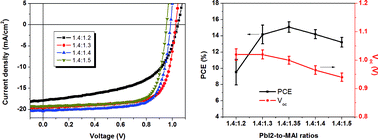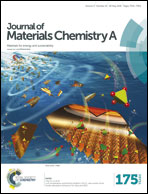Enhancing the planar heterojunction perovskite solar cell performance through tuning the precursor ratio†
Abstract
Perovskite solar cells (PSCs) have attracted great attention due to their high power conversion efficiencies (PCEs) and low fabrication cost. The composition of the precursor solution determines the compositions of perovskite films. Excess precursor(s) may be used in the solution for the fabrication of perovskite films. However, it is still unclear how an excess precursor like PbI2 affects the structure and properties of the perovskite layer and the photovoltaic performance of PSCs. In this work, we investigated the effect of excess PbI2 that has a large bandgap on the electronic structure and properties of perovskite films and the photophysics and photovoltaic performance of PSCs. The presence of slightly excess PbI2 can affect the crystal structure and thus shift the Fermi level of perovskites. It can increase the open-circuit voltage (Voc) and thus the PCE of PSCs. However, the presence of a large amount of excess PbI2 is detrimental to the photovoltaic performance of PSCs. It can shorten the carrier lifetime, increase the resistance of the perovskite films, and decrease the fill factor (FF) and PCE of PSCs.



 Please wait while we load your content...
Please wait while we load your content...